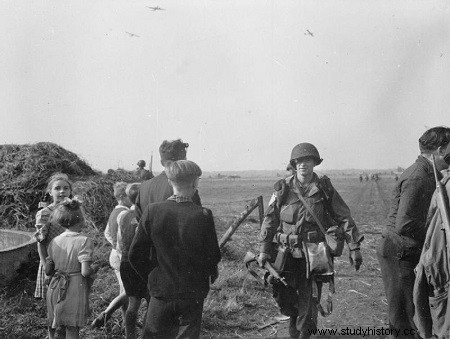
In Nijmegen, however, the capture of the bridge over the Waal proved difficult and dangerous. General Gavin had planned to storm this bridge on Monday morning, but even before he could give the signal to leave, the enemy had counter-attacked, coming from the Reichswald, and recovered the eastern areas. landing where gliders carrying refinery and artillery reinforcements were expected shortly.
After a heavy fight, the Germans were pushed back and the gliders, fortunately delayed two hours by fog, were able to land without too much damage.
But the next day the second wave of gliders loaded with infantry was pinned down by fog, and Gavin was joined on the outskirts of Nijmegen by the grenadiers of the Guard, the Germans to the east that he could detach only one of his three parachute regiments to support the grenadier tanks which were attacking the road and rail bridges over the Waal. The approaches to these mountains were solidly defended (the road had been so well fortified before the war that it had taken three days for the (Germans to seize it in 1940) and attempts by the Guards or paratroopers to force the defenses in the day of pardi had all been repulsed.In fact, the German command was so convinced that the road bridge was impregnable that they forbade its destruction.
Wednesday morning, in spite of the heavy losses of the previous day and the almost insurmountable difficulties presented by the enemy's defences, the attacks had resumed. Applying the plan prepared by General Horrocks and General Browning—the latter had just landed near Nijmegen to take the direction of airborne operations, the attack on the bridges was launched simultaneously from the north and from the south.
The attack from the north was carried out by the American 504th Parachute Regiment which, having driven the Germans out of Nijmegen in the morning, had begun to cross the river two kilometers upstream, at 3 p.m., with its boats of assault, delayed both by the rapid current and by heavy enemy fire.
Although barely half the boats of the first detachment managed to land on the other shore, the Americans managed to set up a small bridgehead and hold on to it while the following detachments crossed the swirling waters. Towards the end of the afternoon, they had burst from their bridgehead and planted the Stars and Stripes at the northern end of the railroad bridge. They were now advancing towards the road bridge.
Seeing the flag waving in the distance through the smoke, the South Rim Guards believed it was a signal and the time had come for them to launch their attack. Pushing their way through the works of the last enemy strongpoint and under the fire of the 88s, the British tanks moved in the direction of the bridge over the Waal while Gavin's regiments still held back the enemy's pressure in from the Reichswald. Shortly after 9 p.m. that evening, four tanks had reached the bridge. Two of them were immobilized by the fire of the anti-tank guns, well sheltered behind the steel beams, but the other two had reached the opposite bank, after having crushed the enemy jam as they passed and had made the junction with the Americans on the north shore. An hour later, the bridge was firmly held by the Allies.
The operation that the men of the Guards Armored Division and the 82nd American Airborne Division had just carried out together was certainly the one of the boldest and brightest of the war. When the case was over, General Dempsey was to tell General Gavin, "I'm proud to meet the commander of the finest division in the world!" and the compliment was not exaggerated.
The road to Arnhem was therefore open and the leading elements of the 30th corps had already
received their orders to to the aid of the British 1st Airborne Division at dawn.
It was indeed three long days and more that the English of Arnhem, isolated, fought with the energy of despair. class='autobr' />hoven, Marshal Model, commander of Army Group B, was drinking a glass of wine as an aperitif on the terrace of the Hotel Tafelberg in Oosterbeek.
The Hotel Tafelberg was the seat of his P.C. and was less than three kilometers west of Arnhem.
It is certain that if the English had not didn't think for a minute of finding himself in the presence
of an adversary of this size, neither he nor General Student, commanding the 1st Parachute Army (and whose P.C. was a little further south, at Vught), did not expect an airborne attack from the Allies.
Student (whose command extended over the German forces already installed in Holland and over the parachute regiments and the battalions of the Luftwaffe transformed into infantry units) saw his numbers swell hour by hour by the addition of important detachments of the XVth Army, which, for several days, had been slipping out of the Allied pincer movement which was slowly advancing from the Belgian border, and had crossed the Scheldt estuary to the northeast of Antwerp.
Student certainly expected that his troops would soon come under attack from the British Second Army, but this time he was, as he had to admit himself, "completely surprised" by Operation Market Garden Never having believed in the possibility of an airborne attack on this sector, he later wrote:In truth, it was quite logical to use airborne troops in such a situation to s capture bridges before they were demolished. But I must admit that our corps commanders as much as our troops - and me first, with all my staff - we were all so overwhelmed, overworked, conditioned by the thousand tasks each more delicate than the other which imposed themselves it's up to us that we no longer see operations except with the eyes of infantrymen
